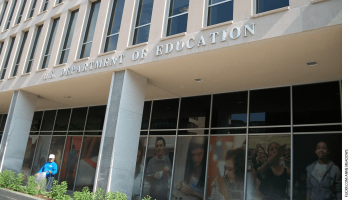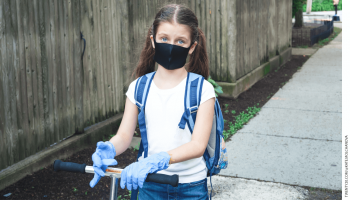
The rapid pace of Covid-19 -related school closures forced districts to switch to remote-learning plans under incredible time pressure. This urgent instructional retooling resulted in wide variation in program quality across a number of factors-including when remote instruction actually began. Even though many districts responded quickly and started providing instruction almost immediately after school buildings were shuttered, others didn't provide remote learning until weeks after closures began.
Timing only agreed to be one small piece of the remote-learning puzzle districts had to solve, however. The Covid-19 Educational Response Longitudinal Survey, or C-ERLS, that we lead, has attempted to gauge the full spectrum of school districts' efforts, including those related to technological supports and instructional platforms, over six waves of nationally representative data collected in 3 months. Over time of swift change through March and April, the data on remote-learning offerings stabilized in May, giving the opportunity to clearly compare variations between districts. Although the sample size is small, its statistical power can nonetheless detect substantial differences-many of which give cause for concern.
Only about one in five schools has a remote-learning program that meets the standard we understood to be \”rigorous.\” Remote-learning programs are less rigorous in additional schools in historically higher-poverty and low-achieving districts compared to wealthier, higher-achieving districts. These district-level differences in remote-instruction offerings through the pandemic may exacerbate existing achievement gaps.
C-ERLS was created in the past of pandemic closures to become rapid, reliable, representative, and repetitive. The first round of data, which assessed districts' early responses in the immediate wake of creating closures, was collected on March 27. Anticipating many changes because the school year progressed, American Enterprise Institute researchers collected data in waves from late March to the end of May. The data used in this short article range from sixth collection wave from May 27 to 29, 2021. Although some districts were already closed by then, these data reflect districts' most recent offerings by the last round of collection where schools were open.
Information was gathered from school-district websites, instead of district personnel, because websites are centralized communication hubs and supply an assuredly high response rate. It is possible that schools offered a lot more than was reflected on district websites, but districts' directives to varsities are the best indicators offered at this initial phase. It is also entirely possible that individual schools or classes didn't stick to the directives on district websites. This data interpretation captures district intent, which may not necessarily result in instructional behavior.
Data comes from a nationally representative sample of 250 regular school districts that reflect the offerings of districts across the nation. I drew the sample to ensure that larger districts-those having a greater quantity of schools-had a proportionately higher chance of being included. Although the data was collected in the district level, those districts' offerings were put on all schools within the district, and answers are reported as percentages of schools, because schools are the level where services are delivered. A lot of the sample, six waves of C-ERLS, along with a more detailed forthcoming report, is available at the C-ERLS webpage.
I used additional data sources to compare schools in districts with higher and lower percentages of minority students and students eligible for free and reduced-priced meals. Measures of minority student composition and poverty, as determined by districts' student free and reduced-priced -meal eligibility, originated from the nation's Center for Education Statistics' Common Core of Data. I defined high-minority and high-poverty districts as those where more than 60 percent of scholars are non-white and entitled to free and reduced-price meals, respectively. To divide districts by student achievement, I made use of data in the Educational Opportunity Project in the Stanford Education Data Archive, which offer comparable measures of student math and reading achievement based on state tests from soccer practice years 2009 to 2021. Though somewhat dated, these scores are comparable across states and adequate to categorize districts based on their historical achievement.
Remote-learning efforts differ across districts, as detailed further below, but no single aspect captures the entire package of remote-instruction education. A combination of data points, however, can offer a far more holistic assessment of potential instructional quality. We placed districts in one of three categories depending on how instructional offerings might, or may not, approximate the classroom instruction students receive when school buildings are open.
Overall, 40 percent of schools were in districts with perfunctory programs, and 40 percent were in districts with moderate programs. One in five schools, or 20 percent, were in districts whose websites described rigorous programs of remote instruction.

Figure 1 shows stark differences in remote-instruction offerings by levels of poverty and academic achievement. 1 / 2 of schools in higher-poverty and lower-academic achievement districts had perfunctory instructional programs, when compared with about a third of wealthier and higher-achieving districts. The share of schools with rigorous remote instructional programs in high-poverty and low-achieving districts was about half the share in low-poverty and high-achieving districts.
In contrast, there was little difference in the percentages of schools offering rigorous, moderate, or perfunctory performance by district minority-student composition. This contrast, which persists through most of the other instructional offerings reviewed in the following paragraphs, suggest that districts' pandemic responses might have had dynamics different from those often found in education research, where minority and poverty influences in many cases are interrelated.
Remote instructional platforms make reference to the techniques districts used to deliver happy to students. C-ERLS captured three platforms: instructional packets, which provide students static material to work on within a week or weeks; asynchronous platforms, like Google Classroom, that permit teachers to supply and collect materials online throughout the school day or week; and synchronous platforms, like Zoom or Google Hangouts, which allow entire classes or groups of students to participate in live video instruction at the same time. Figure 2 displays the percentages of schools that offered, and trusted, these platforms during remote instruction.
| Poverty | Achievement | Minority | |||||||
| High | Low | High | Low | High | Low | ||||
| Platforms offered | |||||||||
| Instructional packets | 92% | 79% | * | 79% | 88% | + | 91% | 80% | * |
| Asynchronous | 77% | 89% | * | 90% | 81% | + | 91% | 83% | + |
| Synchronous | 33% | 49% | * | 52% | 36% | * | 39% | 46% | |
| Platforms primarily relied on | |||||||||
| Instructional packets | 29% | 17% | * | 16% | 26% | + | 15% | 23% | + |
| Both packets and platforms | 21% | 17% | 14% | 23% | + | 23% | 16% | ||
| Online platforms | 50% | 66% | * | 70% | 51% | * | 63% | 60% | |
Instructional packets can be finished with little interaction between teachers and students and permit for a lower quality of instruction, typically, than online platforms might. A bigger percentage of schools in high-poverty or low-achieving districts offered these packets than in low-poverty or high-achieving ones. A lower number of schools in high-poverty districts offered online platforms of any sort, whether synchronous or asynchronous. High-minority districts offered both packets and asynchronous platforms in additional schools than low-minority districts. Many districts offered several option, usually when districts used asynchronous platforms his or her first platform but provided paper packets as backups for students with insufficient use of technology.
To go beyond what districts offered and capture which platform districts relied on primarily for remote instruction, the C-ERLS team categorized districts by whether their instructional program relied mainly on online platforms, primarily on instructional packets, or equally on.
The only improvement in platforms trusted by high- and low-minority districts was for instructional packets, that have been more often relied on by schools in low-minority districts. The pattern of differences by poverty and achievement was more pronounced. Compared to lower-poverty and higher-performing districts, more schools in high-poverty and low-performing districts offered and relied on instructional packets. Both asynchronous and synchronous instruction was more prevalent in more-advantaged and higher-achieving districts.
Certainly, instructional packets have their place being an emergency remote-instructional platform throughout a pandemic and may emulate homework that students receive in normal times. Typically, though, packets alone are likely much further from typical instruction than online platforms. These differences persisted and are evident eight weeks after most school closures started, beyond the initial chaos. The fact that districts with more-disadvantaged students offered the least-ambitious platforms after so much time had elapsed suggests more students in those districts received lower-quality remote instruction than students in other districts.
With the shift to online instruction, access to the internet and devices became a precursor to learning in many districts. Most schools were in districts that offered technology help students. Help with internet access was similar across districts by poverty level, but device loans were more common in low-poverty districts.
A smaller share of schools in high-poverty and low-achieving districts had explicit expectations for one-on-one contacts between teachers and students. High-poverty districts also have lower percentages of students getting grades for remote work, driven through the lower percentage of schools grading work according to performance.
| Poverty | Achievement | Minority | |||||||
| High | Low | High | Low | High | Low | ||||
| Technology Assistance | |||||||||
| Internet | 68% | 70% | 72% | 67% | 87% | 62% | * | ||
| Devices | 57% | 70% | + | 70% | 61% | 72% | 63% | ||
| Expectations | |||||||||
| One-on-one Contact | 64% | 79% | * | 79% | 70% | + | 77% | 73% | |
| Participation | 56% | 66% | 66% | 59% | 63% | 63% | |||
| Attendance | 21% | 35% | * | 36% | 25% | + | 24% | 34% | |
| Grading work | |||||||||
| Any grading | 63% | 69% | 68% | 66% | 72% | 65% | |||
| For performance | 25% | 34% | 31% | 32% | 32% | 31% | |||
| For completion | 37% | 34% | 37% | 34% | 40% | 33% | |||
Technology assistance was available in more schools in districts with higher percentages of minority students. These districts offered more help with internet access (87 percent of high-minority districts versus 62 percent of districts with lower percentages of minority students). There were no measurable differences in districts' expectations for one-on-one contact, student participation, attendance, or grading policies between high- and low-minority districts.
The Covid-19 pandemic could well be the largest disruption America's K -12 education system has ever faced. For students, this disruption-and the variations in districts' response to it-will harm academic achievement and certain exacerbate longstanding achievement gaps.
School and district leaders will have their hands full next school year, not just negotiating the continued uncertainty of coronavirus, but additionally assessing the progress students make, or otherwise made, since mid-March. They will soon have to implement sustainable instructional programs to create up lost ground.
Schools will also have to take practical measures to re-open, potentially forcing some to start the year with remote instruction. Adding insult to injury, districts face this continued challenge with significant projected revenue shortfalls and budget tightening.
C-ERLS data darken a previously bleak picture. The academic recovery from the coronavirus pandemic, it appears, will be a long one. Should schools and districts not rise towards the task ahead, students will be the ones to deal with the heaviest load, particularly those in low-achieving, higher-poverty districts.





